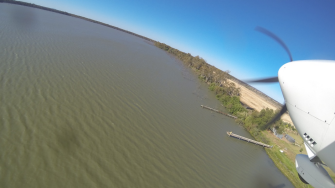
Date: Tuesday, November 7, 2017
Project: Eastern Australian Waterbird Survey
Plans went a bit awry today with a sequence of events related to the weather and planes (not ours) which meant we didn’t get away until 2pm from Sydney. Our scheduled survey day all the way to Swan Hill had to be changed. We wouldn’t get that far in half a day. Realigned – we set off west for Griffith. First, we surveyed the wetlands of the Lachlan River. First up Lake Cowal.
It is a stunning expanse of water but drying back along the margins.
Lake Cowal drying back around the margins but still with plenty of water.
Surveying the western shoreline of Lake Cowal
I thought we would see thousands of waterbirds, perhaps more than 10,000 in total but we were only counting in the hundreds and so the total numbers were considerably less than 10,000. Now that the lake has been flooded for a few years, it may have lost some of its productivity.
Interestingly, we always know if a wetland is productive by the number of insects squashed on the wing and windscreen of the plane. Lake Cowal wasn’t a great bug catcher today.
The lake has a large open pit gold mine on its western shoreline. This abuts the lake and now intrudes into the lake.
Surveying the western shoreline of Lake Cowal; the land in the distance is where the gold mine intrudes into the lake.
Once we had surveyed the shoreline, there was a ‘tongue’ of lignum and red gum stretching into the middle of the lake which also often has feeding waterbirds. There were a few but not many – mostly coot, pelicans and grey teal.
Surveying the ‘tongue’ of lignum in Lake Cowal.
These ‘islands’ of vegetation often hold nesting colonies and today was no different. In the red gum part, there were about 150 nests of straw-necked ibis. We even saw four magpie geese which ‘behaved’ as if they may be nesting. They were sitting close together on a clump of lignum. They are one of the really good news stories of the waterbird world – magpie geese seem to be turning up more often on Murray-Darling Basin wetlands than they did in the past. We know they breed on Lake Cowal and also the Macquarie Marshes.
Hard to see but there was a straw-necked ibis colony on lignum bushes in the red gums on Lake Cowal.
North of the main Lake Cowal lake, the connected Nerang Cowal is a large lake in its own right, albeit only about a third of the size of the main lake. Nerang Cowal dries back first and its shallow waters had hundreds of grey teal and pied stilts. Despite this, it didn’t have the numbers of waterbirds that I had predicted, given how dry everywhere else was. It too may have lost some productivity in terms of invertebrate densities.
Surveying Nerang Cowal, just north of Lake Cowal.
From here, we worked our way north to another large wetland Bogandillon Swamp. It is considerably more ephemeral than the other two lakes and had dried right back. Its shallow margins had higher density flocks of waterbirds than the Lake Cowal lakes.
Feeding pelican flock on Bogandillon Swamp, just north of Lake Cowal
Then on to the Lake Cargellico system, near the town of the same name. It has a couple of shallow lakes to the north which were crowded with waterbirds. They were hundreds of teal, black swans, pink-eared ducks and whiskered terns. The shallow water with its vegetation made these lakes very productive in terms of invertebrates, plants and even fish – obviously demonstrated by the large numbers of waterbirds.
Contrastingly, the much larger Lake Cargellico only had a few cormorants and pelicans, as well as a flock of about 50 Australian shelduck. Its artificially high water levels means the productivity for waterbirds is low.
Surveying Lake Cargellico on the Lachlan River
By the time we had finished these lakes, it was getting late and we headed for Griffith for the night.
